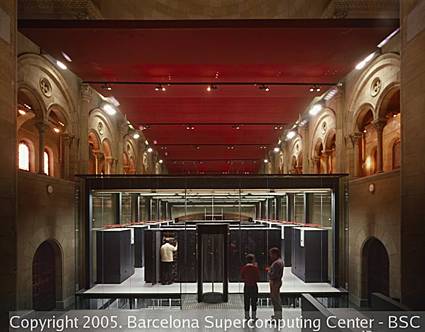Taming the Wild Supercomputer
Introduction
Editor's Note: Sam Holland is an engineer who loves the challenge of innovative computing ventures. I first met Sam when he questioned my contention that the AlphaMicro AM100 was first multiuser, multitasking microcomputer. He argued convincingly that his company's Extensys EX3000, though never brought successfully to market, was the real first in this area. Sam is currently involved in designing and prototyping a supercomputer. Here he contends that supercomputers belong in the office and then shows how most supercomputers are designed to make them office unfriendly. Sam has both technical and business experience with supercomputers and he discusses both in this article. Topics include: Custom Processor Architecture and Interconnects, Power And Heat, Big, Noisy And Impossible To Relocate, Customize The Operating System, Extreme Effort for Application Development.
The Barcelona Supercomputing Center combines the old with the new.
I believe that everyone is an entrepreneur. Entrepreneurs take on risks to achieve success, usually financial. It's easy to peg business leaders' entrepreneurial abilities because their successes are highly visible. However, the software engineer who has just improved a search engine's ability to locate the perfect URL is also an entrepreneur. The engineer is putting his job and his salary and other job-related rewards on the line. Perhaps this engineer's search code might be the basis for another entrepreneur's perfect business model that leads him or her to success.
So what do entrepreneurs have to do with supercomputers? First, consider that virtually every one of the top 500 supercomputers (www.top500.org) is made up of a cluster of microprocessors woven together by an interconnected fabric. The systems are normally optimized for compute-intensive applications. Diverse processors are used and even more diverse fabrics are employed. Some use commodity microprocessors and fabrics while others use custom parts.
The dinosaur-like computers of the past used a small number of physically large, custom processors. These are gone, having given way to larger and larger numbers of small, fast microprocessors, often configured as a room full of servers. Traditional compute intensive architectures are capable of moving toward more interactive forms of applications. Some of the most powerful supercomputers in the world, for example, are used in web-based applications.
Supercomputers are becoming commonplace, thanks to faster microprocessors and more sophisticated clusters of servers. But do you have one in your office? Probably not. They are expensive and take up a huge amount of space. They are hot, noisy, temperamental, and surrounded by a gaggle of experts who approach computing in ways that are semantically different from business-oriented computer experts. That doesn't have to be the case.
What is needed is engineering entrepreneurship. Creative risks need to be taken that move supercomputers from the perception that they need to be complex into something that can exist in an office environment.
Get Tom's Hardware's best news and in-depth reviews, straight to your inbox.
My approach for this article is somewhat left-handed. I have found that looking at a situation from a different perspective helps me to see the obvious. My hope is that you will find obvious, creative solutions to supercomputer issues that currently keep them out of the office. By understanding what makes them office adverse, we have a chance to migrate them into the office. To accomplish this, engineering entrepreneurs are needed. They will probably be invisible, but with a larger domain, bags of money and the willingness to shatter entrenched paradigms.
The topic of supercomputers is huge. Each topic addressed here can fill volumes, so I'm staying away from the details, not only for brevity, but to spare the reader from preconceptions. This helps open the door to creative solutions.
So let's look at the good, bad and indifferent aspects of supercomputers. There is a way beyond preconceptions that can lead you, as an entrepreneurial engineer, to break through existing limitations and put a supercomputer in the office. My apologies, ahead of time, if I leave something out or step on toes. Thank goodness for counterexamples.
Current page: Introduction
Next Page Use Custom Processor Architecture and Interconnects